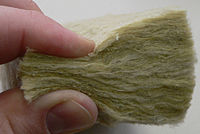
Photo from wikipedia
Abstract The solubility of hafnium dioxide (HfO2), used as a surrogate for tetravalent uranium, is measured in glass melts belonging to the CaO-Al2O3-SiO2 and Na2O-CaO-Al2O3-SiO2 systems, under oxidizing and reducing… Click to show full abstract
Abstract The solubility of hafnium dioxide (HfO2), used as a surrogate for tetravalent uranium, is measured in glass melts belonging to the CaO-Al2O3-SiO2 and Na2O-CaO-Al2O3-SiO2 systems, under oxidizing and reducing conditions. Two methods have been carried out to determine it and the kinetic factors controlling the HfO2 dissolution in glass melt have been investigated in order to approach equilibrium. The solubility ranges from 3 to 6.5 mol% HfO2 in aluminosilicate glasses at temperature between 1250 °C and 1400 °C, and is not affected by the redox conditions. Conversely, the solubility is modified by the melting temperature and the glass composition. The excess of alkalis or alkaline earths which are not involved in the charge balance of AlO4 tetrahedrons in the silica network appears to play a significant role. Glass homogeneity is checked by scanning electron microscopy and X-ray diffraction. HfO2, HfSiO4, Ca2HfSi4O12, Na4Hf2(SiO4)3 and Na2HfSi2O7 are metastable crystals observed in the glass melts. The stability of those crystalline phases mainly depends on the glass composition.
Journal Title: Journal of Non-crystalline Solids
Year Published: 2017
Link to full text (if available)
Share on Social Media: Sign Up to like & get
recommendations!